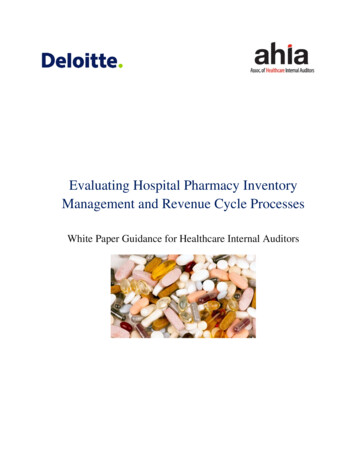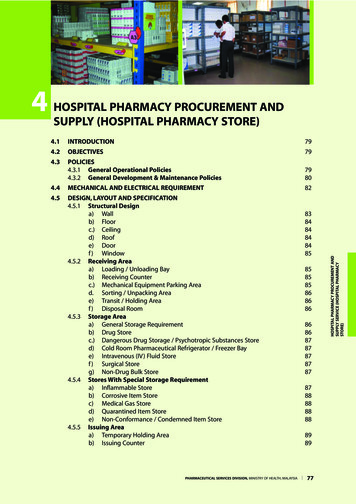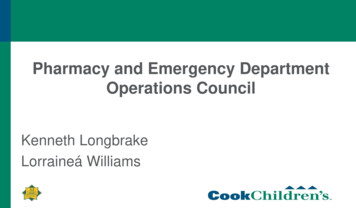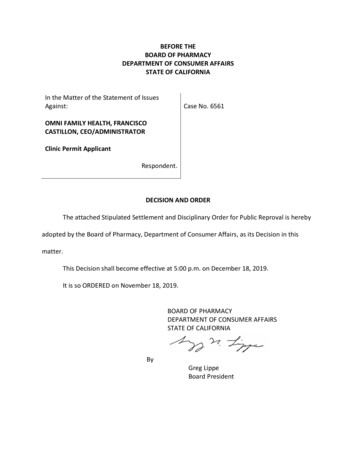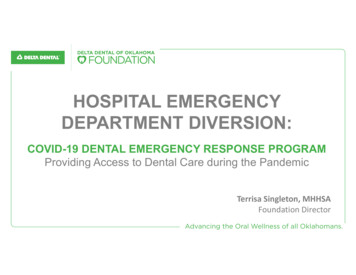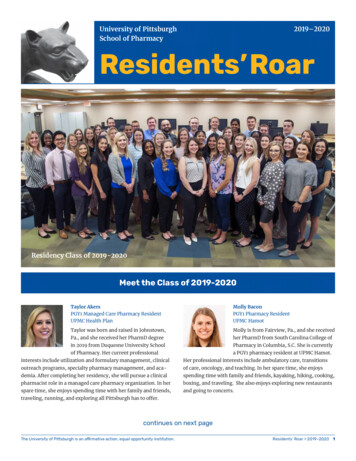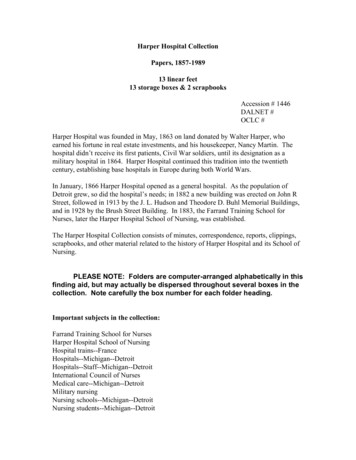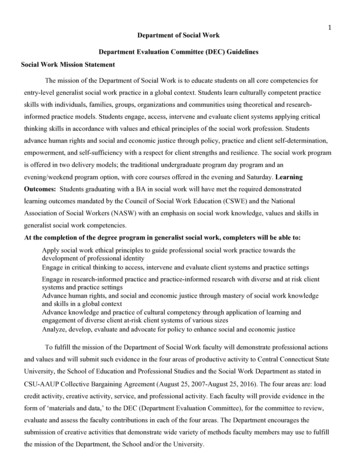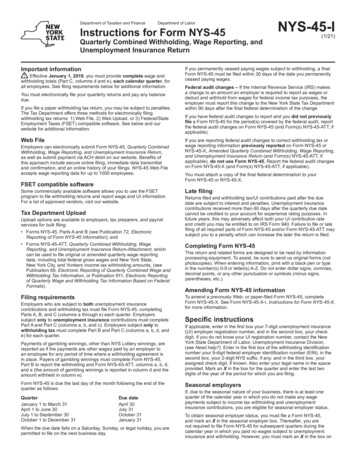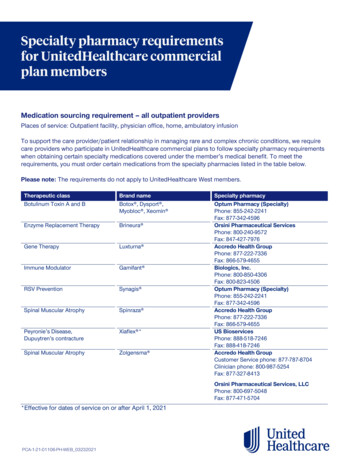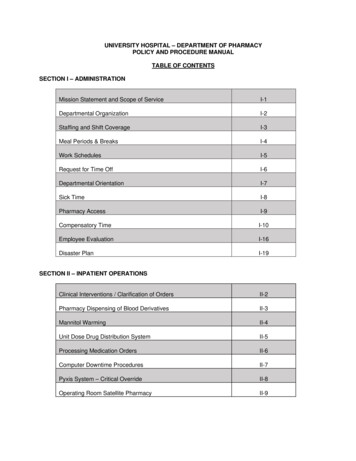
Transcription
UNIVERSITY HOSPITAL – DEPARTMENT OF PHARMACYPOLICY AND PROCEDURE MANUALTABLE OF CONTENTSSECTION I – ADMINISTRATIONMission Statement and Scope of ServiceI-1Departmental OrganizationI-2Staffing and Shift CoverageI-3Meal Periods & BreaksI-4Work SchedulesI-5Request for Time OffI-6Departmental OrientationI-7Sick TimeI-8Pharmacy AccessI-9Compensatory TimeI-10Employee EvaluationI-16Disaster PlanI-19SECTION II – INPATIENT OPERATIONSClinical Interventions / Clarification of OrdersII-2Pharmacy Dispensing of Blood DerivativesII-3Mannitol WarmingII-4Unit Dose Drug Distribution SystemII-5Processing Medication OrdersII-6Computer Downtime ProceduresII-7Pyxis System – Critical OverrideII-8Operating Room Satellite PharmacyII-9
2SECTION III – STERILE PRODUCTSPreparation of Large Volume Parenteral SolutionsIII-1Preparation of Piggyback SolutionsIII-2Beyond Use Dating for Compounded Sterile ProductsIII-3End Product Testing of Sterile CompoundsIII-4Environmental Procedures for the Sterile Compounding AreaIII-5Handwashing/GlovingIII-6Clean Benches and Biological Safety Cabinets - CleanlinessIII-7Gowning, Personal Protective EquipmentIII-8Antineoplastic Agents – PreparationIII-9Checking Parenteral Nutrition SolutionsIII-10Preparation of Sterile Irrigation Solutions with AdditivesIII-11Parenteral Nutrition – Use of the Baxa Exacta-Mix 2400III-12Pump Calibration - PharmAssistTMIII -13SECTION IV – OUT-PATIENT SERVICESSECTION V – MATERIALS MANAGEMENTInventory ControlV-1Procurement of PharmaceuticalsV-2Emergency Drug TransferV-3Ordering of PharmaceuticalsV-4Return of Medication to the PharmacyV-5Medication RecallV-6Checking for Expired MedicationsV-7Disposal of Expired MedicationsV-8
3SECTION VI – REPACKAGING AND COMPOUNDING (NON-STERILE)Repackaging MedicationsVI-1Auto-pac Repackaging ProcessVI-2Labeling for Repackaged MedicationsVI-3Extemporaneous Unit Dose PackagingVI-4Packaging of Oral SyringesVI-5SECTION VII – QUALITY ASSURANCEPharmacy Quality Assurance/Continuous Quality ImprovementVII-1
PHARMACY DEPARTMENT POLICIES& PROCEDURESMANUAL CODE: I-1SUBJECT: MISSION STATEMENT SCOPE OF SERVICESEFFECTIVE DATEEFFECTIVE DATEORIGINAL POLICY: 9/89 REVISED POLICY:02/2005SUPERSEDES POLICYNUMBER:LAST REVIEW DATE:8/2015I.DEFINITION OF SERVICEA.MISSIONThe mission of the Department of Pharmacy is to guide the safe andappropriate use of medication in order to provide optimal pharmaceuticalcare to all patients of Stony Brook University Hospital.B.PURPOSE/VISION/GOALSThe fundamental purpose of pharmaceutical services is to ensure the safeand appropriate use of medications. Our core philosophy is thatpharmacists practicing in academic institutions such as SBUH areexpected to make meaningful contributions to patient care, education,community service and research.Optimal pharmaceutical care can be defined as the identification,resolution and prevention of drug-related problems that affect positivepatient outcomes. We believe that this is best provided through a teamapproach that effectively integrates the knowledge and skills of thepharmacist with those of other health care professionals.Our vision is to ensure the safe and optimal use of pharmaceuticals for allpatients of Stony Brook Medicine by having pharmacists provide a centraland visible role in all aspects of medication management.To fulfill this responsibility Pharmacy is involved with decision makingand actions relating to the procurement, storage, preparation, dispensing,Page 1 of 6
distribution and administration of all drug products. Pharmacy alsoprovides information to support judgments regarding medication selection,dosage, method of administration and monitoring of therapy.Our goals are- to establish the pharmacist as a crucial member of the patient careteam whose presence is recognized as valuable and necessary for theachievement of Stony Brook Medicine’s goal of best clinical practiceand outcomes in at least 10 select disease states. This will involvepharmacist presence in both the inpatient and the outpatientcommunity.- to implement technology and processes that will ensure the safepreparation and dispensing of medication to our patients- to make meaningful contributions to the fiscal viability of theinstitution by establishing specific revenue streams for PharmacyC.FUNCTIONThe services provided by the Department of Pharmacy are divided intofour categories:1. Administrative1. Formulary Management2. Establishing Medication-related Policies and Procedures3. Control of Pharmaceutical Expenditures4. Procurement of Pharmaceuticals5. Total Quality Management6. Pharmacy Information Systems2. Distributivea. Operation of a Unit Dose Distribution Systemb. Operation of a Unit-Based Dispensing Systemc. Compounding of Sterile Products, includingAntineoplastics and Parenteral Nutrition Admixturesd. Investigational Drug Servicese. Satellite Pharmacy Servicesi. Operating Room/Surgical Servicesii. Ambulatory Surgical Centeriii. Cancer Center/Infusion Services3. Clinicala. Decentralized Pharmacist Programb. Pharmacy Specialist Programc. Antimicrobial Stewardship Service4. Educationala. Pharmacy Residency Programb. Pharmacy Continuing Education Programc. Community Education ProgramsPage 2 of 6
D. CUSTOMERSThe Department of Pharmacy serves patients of all ages, physicians, nurses,allied health professionals and hospital administration.E. STAFFINGServices are provided by licensed pharmacists supported by pharmacytechnicians and other members of the departmental staff.The Department of Pharmacy ensures adequate staff to meet patient and othercustomer needs by requesting staff on a programmatic basis. Thus, once aprogram is approved, the staff required to support that program is an integralpart of that approval. A sophisticated computerized scheduling system is usedto ensure staff availability to support each area and program. Vacation orother time-off requests are not granted if the absence will compromisenecessary service. Should an unanticipated staff shortage occur due to staffillness or emergency, members of the staff are cross trained to cover multipleareas. There is also a system for use of per diem staff and for coverage on arecall or overtime basis should the shortage occur on an off shift.F. DELIVERY OF CAREPharmaceutical care is delivered from the Main Pharmacy, which includes theSterile Compounding Area, Antineoplastic and Hazardous DrugCompounding Area, and the Investigational Drug Service; from the SatellitePharmacies located in the Operating Room, Ambulatory Surgery Center, andCancer Center; and by decentralized pharmacists assigned to patient careareas. Pharmacists consult with prescribers, check and fill medication ordersand monitor patient medication therapy to ensure the safe and appropriate useof pharmaceuticals.G. AVAILABILITY OF SERVICEPharmacy services are available 24 hours a day, 365 days a year.II.NEEDS ASSESSMENTCustomer need, as well as appropriateness, clinical necessity and timeliness of theservices provided, are identified through interdisciplinary meetings and throughthe CQI and QM processes.Individualized customer needs are considered through the Formulary processwhere practitioners can request the availability of those medications needed bytheir patients. The Department of Pharmacy provides informational resources tomeet individual customer needs.III.PRACTICE STANDARDSThe Department of Pharmacy operates in accordance with Federal and State lawsregulating the distribution of drugs and the practice of Pharmacy, as well asapplicable standards as written in the Joint Commission Hospital AccreditationPage 3 of 6
Standards Manual, CMS Conditions of Participation, and Practice Standards ofASHP. Institutional guidelines for the operation of the department are set forth inthe Administrative Policy and Procedure Manual and the Departmental Policy andProcedure Manual.IV.VI.PROTECTION OF HEALTHCARE INFORMATIONA.Patient information used by the Department of Pharmacy includes patientname, medical record number, admitting diagnosis, age, height andweight.B.Patient information sources include physician order sheets, labinformation, and patient demographic data, as well as informationobtained verbally from caregivers. Information is stored in patient profilesin the Cerner PharmNet pharmacy computer system and the PyxisMedStation software. After processing, paper physician order sheets areboxed and stored in the Department of Pharmacy for a period of onemonth and then archived to a secure long-term storage center. Ordersheets that have been electronically scanned are available in a retrievablearchive. Orders entered electronically are stored in the EMR.C.Pharmacy data is available to hospital personnel with authorized access tothis information via PowerChart .D.Patient information may be received via paper order, computer profile orby telephone, and is utilized in the preparation, distribution andmonitoring of medication therapy. Patient information leaves thedepartment on the computer-generated labels on both oral and parenteralmedications delivered to the nursing units.CONTINUOUS QUALITY IMPROVEMENT ACTIVITIESA.MODEL USEDThe model for CQI used in the Department of Pharmacy is consistent withthe model used throughout the institution: “Focus – PDCA”.B.KEY CQI FUNCTIONSThe key CQI functions of the Department of Pharmacy address patientsafety within the medication use process. This process includes medicationprocurement, storage, prescribing, preparation, distribution, administrationand patient monitoring.C.STAFF PARTICIPATIONThe department supports staff involvement in Hospital Committees thatplay an active role in QA/CQI activities. These include but are not limitedto the Patient Safety Committee, the Medication Safety Committee, thePage 4 of 6
Pharmacy/Nursing Committee and the Pharmacy Departmental ProcessTeams.D.INDICATORS USED AND DATA MONITOREDINDICATORVII.DATA1. Medication ErrorsType of error, unit, process(es), shift,severity, medication type2. Adverse Drug ReactionsDrug(s), type of reaction, location, severity,probability, preventability3. Pharmacist InterventionsType of intervention, date, acceptedoutcome, significance, cost avoidance,pharmacist or area4. Nursing area inspectionsUnit, compliance with regulations,problems found, resolution5. Non-Formulary drugsDrug, frequency, cost6. Drug UtilizationEvaluationsAppropriateness of order (including dose,frequency, drug-drug interactions),dispensing (order entry accuracy, etc),administering (potential drug-drug/foodinteractions, time of day (if relevant), rare,etc) and monitoring (i.e., adverse drugreaction, outcome)7. Workload StatisticsNumber of IV preparations, chemopreparations, infusions, TPNs, etc.8. Controlled DrugDiscrepanciesNursing unit, date, drug, dosage form,quantity, corresponding sheet number (ifapplicable)ORIENTATION AND EDUCATIONIn addition to the hospital orientation, all Pharmacy personnel receive extensivetraining within the department before assuming their responsibilities. New staffmust be signed off in each area before being allowed to practice. Periodic inservice educational programs are conducted and, when feasible, staff isencouraged to attend pertinent lectures and teaching rounds conducted in thePage 5 of 6
Hospital or Health Sciences Center. Continuing Education is a mandatoryrequirement for re-licensure of pharmacists. Each pharmacist must complete 45hours of formal ACPE-accredited Continuing Education for each triennialregistration period. The Pharmacy Department at Stony Brook UniversityHospital is an ACPE-approved provider of continuing education. Orientation andtraining are documented in each employee’s departmental record.Page 6 of 6
PHARMACY DEPARTMENTPOLICIES & PROCEDURESMANUAL CODE: I-2SUBJECT: DEPARTMENTAL ORGANIZATIONEFFECTIVE DATEEFFECTIVE DATEORIGINAL POLICY: 11/03 REVISED POLICY: 11/05SUPERSEDES POLICYNUMBER:LAST REVIEW DATE:05/2014POLICY:The manner in which the Department of Pharmacy is organized isestablished.SCOPE:PharmacyKEYWORDS:Department, table of organizationFORMS:POLICY CROSS REFERENCE:DEFINITIONS:PROCEDURE:The Department of Pharmacy shall be directed by a professionallycompetent and legally qualified pharmacist.It shall be staffed by a sufficient number of competent personnel,in keeping with the size and scope of services to the hospital.The Department of Pharmacy is organized as shown in thefollowing Table of Organization.Page 1 of 1
ADMINISTRATIVE POLICIES &PROCEDURESMANUAL CODE: I-3SUBJECT: STAFFING AND SHIFT COVERAGERESPONSIBLE DEPARTMENT,DIVISION OR COMMITTEE: PHARMACYEFFECTIVE DATEEFFECTIVE DATEORIGINAL POLICY: 11/03 REVISED POLICY: 11/03SUPERSEDES POLICYNUMBER:LAST REVIEW DATE:05/2014POLICY:The Pharmacy is staffed to ensure that a full range of services for patientsat Stony Brook University Hospital is provided.SCOPE:PharmacyKEYWORDS: Staffing, coverage, scheduleFORMS:Daily schedule, off shift coverage listPROCEDURE: Staffing levels will be maintained on all shifts to permit the Pharmacyto fulfill its mission 24 hours a day, 7 days a week.I.STAFFINGA.Work schedules are published 30 days in advance and dailyassignments are posted weekly and further refined forparticular areas as appropriate.B.To fulfill the Pharmacy’s mission and to ensure adequateprovision of service it may be necessary to assign staff toany work area or on other shifts.II.OFF SHIFT PHARMACY COVERAGEA.Off-shift Coverage List (OCL)1. A dayshift pharmacist OCL list will be comprised of allsenior and full-time and part-time staff pharmacists, asassigned by the Director. A current and updated copy ofthe OCL will be posted by Pharmacy Administration.Page 1 of 3
2. The AM shift pharmacist OCL will be comprised of allevening shift senior and staff pharmacists.3. A separate dayshift OCL will be comprised of all day shiftpharmacy assistants. This list will exclude the ORtechnician.4. The names on lists will rotate. Everyone must work anextra shift in order to get off the top of the OCL.5. All new pharmacists and pharmacy assistants, once trained,will have their name added to the bottom of the appropriateOCL.B.Implementation to Obtain Coverage1. When it is known that a specific shift requires additionalcoverage, the staff member who is at the top of theappropriate OCL will be notified.2. If the staff member at the top of the list is not present, thenext staff member on the list who is present will berequired to work the extra shift.3. If this is a problem for the staff member, the pharmacyadministrator in charge or his/her delegate will send aphone message to all pharmacy areas identifying thatcoverage is needed and soliciting volunteers.4. If there are no volunteers available, it will be theresponsibility of the staff member designated to work, toeither work the extra shift or find coverage.5. Once someone works an extra shift, that staff member’sname goes to the bottom of the OCL.6. If two staff members elect to split an eight shift, the staffmember highest on the OCL goes to the bottom of theOCL.7. If a staff member elects to volunteer to work an extra shifthis or her name goes to the bottom of the OCL.8. If it is known that a specific staff members schedule mustbe covered for an extended period of time, the followingprocedure will be enacted:a. It will be determined by Pharmacy Administration whatdates coverage will be needed, after review of theexisting schedule and rescheduling as appropriate.Page 2 of 3
b. This list of dates will be posted with an attachedsolicitation for volunteers.c. Volunteers for this purpose shall be entitled to allbenefits of anyone responsible for the extra coverage.d. As a last resort if no volunteer coverage is available,then, on those dates, the appropriate OCL will beutilized for coverage.9.If a staff member is mandated to stay, for any reason, forgreater than two hours beyond his or her normal shift, thanthat staff member’s name will be placed on the bottom ofthe OCL.10.A staff member who is working as a result of a switchwith another staff member whose name is at the top of theOCL will not be the first designated to work an extra shift.The working staff member maintains his/her name positionas listed on the current OCL.Page 3 of 3
ADMINISTRATIVE POLICIES &PROCEDURESMANUAL CODE: I-4SUBJECT: MEAL PERIODS AND BREAKSRESPONSIBLE DEPARTMENT,DIVISION OR COMMITTEE: PHARMACYEFFECTIVE DATEORIGINAL POLICY: 11/03EFFECTIVE DATE REVISED SUPERSEDES POLICYPOLICY: 06/04NUMBER:LAST REVIEW DATE: 5/2014POLICY:A procedure for allocating time for meals and breaks is established.SCOPE:PharmacyKEYWORDS:meals, breaksFORMS:POLICY CROSS REFERENCE:DEFINITIONS:PROCEDURE:The Assistant Director or designated supervisor, on a daily basis, shall beresponsible for assigning meal periods and breaks.1. UUP personnel are entitled to 60 minutes per shift for meals. Meals are tobe taken at times assigned by the Senior Pharmacist in consideration ofworkload.2. CSEA personnel who work 40 hours per week are entitled to 30 minutes pershift for meals.3. Up to two 15 minute breaks may be allowed if workload permits at thesupervisor’s discretion for both bargaining units.4. Breaks are considered “time worked” and are not an entitlement. All staffmust obtain permission from a supervisor prior to taking a breakPage 1 of 1
ADMINISTRATIVE POLICIES &PROCEDURESMANUAL CODE: I-5SUBJECT: MONTHLY WORK SCHEDULERESPONSIBLE DEPARTMENT,DIVISION OR COMMITTEE: PHARMACYEFFECTIVE DATEEFFECTIVE DATEORIGINAL POLICY: 11/03 REVISED POLICY: 11/05SUPERSEDES POLICYNUMBER: I-5LAST REVIEW DATE:05/2014POLICY:The Pharmacy provides patient care services every day of the year,24 hours a day. Work schedules are established for the purpose ofinsuring such patient care is hly SchedulePOLICY CROSS REFERENCE: I-6 Request For Time OffDEFINITION:The monthly work schedule indicates which staff persons willwork during each shift on a given day over a four-week period.PROCEDURE:1. The monthly schedule will be prepared and distributed at leastfour weeks in advance by the Pharmacy supervisor assigned todo so.2. Departmental needs will have priority when planning theschedule and additional shifts may have to be scheduled inperiods of short staffing.Page 1 of 2
3. All Pharmacy personnel may be required to work any shift in a24 hour period and on any day of the week consistent withunion contracts and federal and state law to maintain adequatestaffing to provide for patient medication needs at all times.4. All changes in work schedules initiated by the staff must beapproved by Pharmacy Administration in advance of thechange.a. All parties involved in any schedule change mustacknowledge their consent to the change to the properPharmacy administrator.5. Should it become necessary for Pharmacy Administration tochange an employee’s work schedule, the employee will benotified of the change as required 4 weeks in advance.6. Personnel are expected to be present at their assigned area atthe scheduled time for the start of the shift.7. Frequent tardiness is not acceptable and may subject theemployee to corrective action.8. Personnel may not leave before the end of their shift withoutthe approval of Pharmacy Administration.9. The Pharmacy Supervisors will be responsible to document alltardiness, and early departure in the department.Page 2 of 2
ADMINISTRATIVE POLICIES &PROCEDURESMANUAL CODE: I-6SUBJECT: REQUEST FOR TIME OFFRESPONSIBLE DEPARTMENT,DIVISION OR COMMITTEE: PHARMACYEFFECTIVE DATE ORIGINAL EFFECTIVE DATE REVISEDPOLICY: 08/22/84POLICY: 09/15/2003SUPERSEDES POLICYNUMBER:LAST REVIEW DATE: 05/2014POLICY:The mechanism by which a member of the Pharmacy Department may requesttime off and the criteria to be used in granting such requests is established.DEFINITION:Time off from a regularly scheduled working day will mean:a) compensatory time for working holidays or extra shiftsb) vacation daysc) personal days (where permitted under union contract)FORMS:Time Off Re
Pyxis System – Critical Override II-8 Operating Room Satellite Pharmacy II-9 . 2 SECTION III – STERILE PRODUCTS . SECTION V – MATERIALS MANAGEMENT Inventory Control V-1 Procurement of Pharmaceuticals V-2 . and visible role in all aspects of medication management.
